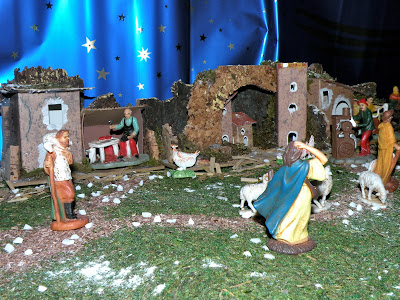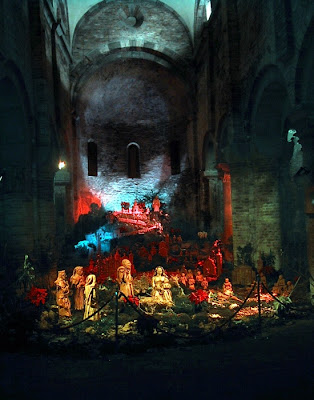Done, our version of Nativity Scene is ready this year too! A bit early, as usually set up starts on December 8, the day of the Immaculate Conception, but we're never home at Christmas, so since last year we took this habit to put up our decorations earlier. In this way we can enjoy them more.
We followed the tradition to leave the manger empty. Baby Jesus arrives at Midnight on Christams Eve and that's when he should be placed in there. We won't be home on that day, but well, our baby Jesus will have a bed to lie in earlier.
We followed the tradition to leave the manger empty. Baby Jesus arrives at Midnight on Christams Eve and that's when he should be placed in there. We won't be home on that day, but well, our baby Jesus will have a bed to lie in earlier.
It took us 2 days to build this presepe and I like the tiny result. This year we improved in terms of nature. We put up a bigger and more elaborate lake, made a nicer mountain and even built a sheeps fence. Plans for next year are to improve the village part. Nothing elaborate, we kept it simple because I like our presepe to grow along with Alice, according to her manuality and skills. For what we wanted to do this year, our figures were enough. I don't like a crowded ground after all.
The first presepe was created by Saint Francis of Assis when he recreated the scene of Christ's Nativity in 1223. St. Francis's "Institution of the Crib" was captured in the painting by Giotto below.
He popularized the image of the crib and started the tradition of the presepe. Since then, the representation of the nativity has spread all over Italy in many ways. The stylistic shapes and the use of materials are deeply influenced by geographical place and popular traditions.
In the 15th century they used large statues of saints in churches, launching the tradition of nativity sculptures in sacred places. One of the oldest is monumental presepe in the Basilica of Santo Stefano in Bologna.
In the 15th century they used large statues of saints in churches, launching the tradition of nativity sculptures in sacred places. One of the oldest is monumental presepe in the Basilica of Santo Stefano in Bologna.
Slowly nativity scenes started to appear in the houses of noble families and were displayed as knick-knacks or as miniature chapels. Then in the 18th century, the Bourbon king Charles III got a real passion for this art form and under his reign Naples became the capital of the presepe.
This passion for presepe influenced the entire population, beginning with the king who, having a deep interest in sophisticated mechanical models, with the help of architects and artists added mechanized figurines to the presepe. His wife, the queen Maria Amalia, spent months sewing rich dresses for the statues, assisted by court tailors. It started a sort of competition between families over who had the most valuable presepe: the nobles devoted rooms of their mansions to display magnificent nativity scenes with statues covered in precious clothes and real sparkling jewels. Among the many statues crowding such rich presepi, it was possible to recognize characters of the local nobility as well as the middle and lower classes, all engaged in their typical daily activities: drinking in taverns, fishing, selling products by the road, dancing, serenading a woman, etc. (credit)
Such moments going beyond the original sacred intent and inspired by contemporary life with geographical elements gave birth to the peculiarity of San Gregorio Armeno. This street in central Naples is filled with shops displaying stands full of nativity scenes. And near the traditional statues it is possible to find contemporary figures, from presidential candidates for the White House to Italian politicians or celebrities.
Obama's stuff
Our quotable premier never misses a caricature. This year he's celebrated with Ruby, the girl who costed him another sexy scandal and the crisis of his government.
This year another character is Padre Zanotelli, the pastor depicted with a phial of water in hand because he has been very committed in the fight against water privatization in schools and universities.
Anti mafia writer Roberto Saviano and TV Presenter Fabio Fazio -source
Also, the best presepi are in Naples, where hundreds of nativity scenes are erected throughout the city. Some of them are very elaborate and are mostly handmade. Some statues are true antiques and therefore very expensive.
The Roman Baroque tradition is another important period in the history of presepi. In Rome the most important families created magnificent presepi to be displayed with pride during sumptuous Christmas dinners. The Roman presepe, like the Neapolitan, reproduced the typical local country landscape with pine and olive trees and the ancient aqueducts in the background. With time, presepi appeared in common people’s homes and became a deeply respected tradition in Italy.In the Vatican there is a huge presepe in St. Peter’s Square for Christmas. In Rome some of the biggest and most elaborate presepi can be found in many important churches.
Another important tradition in Italy is the living nativity scene called presepi viventi. Costumed people act out the events of the nativity, sometimes over several days, usually on Christmas Day, December 26, as well as on January 6, the day of the Epiphany which is also the day when the Magi brought their gifts to Jesus.
There are many living nativities all over Italy and during such festivities the entire town are set up to resemble an ancient village with craftspeople and small shops. I'm emotionally attached to the one held in my region, in Rivisondoli, Abruzzo. Every year it has hundreds of costumed participants.
There are many living nativities all over Italy and during such festivities the entire town are set up to resemble an ancient village with craftspeople and small shops. I'm emotionally attached to the one held in my region, in Rivisondoli, Abruzzo. Every year it has hundreds of costumed participants.
Mentioning my region reminds me that Abruzzo has a special figure, the zampognaro (the shepherd-bagpiper), who comes down from the mountains at Christmastime, going door-to-door to play bagpipes to announce the birth of Christ. This tradition continues today and I miss that. Hearing their music in the streets is what I associate to Christmas more! (Listen to their music here.)
From starry skies descending,
Thou comest, glorious King,
A manger low Thy bed,
In winter's icy sting;
O my dearest Child most holy,
Shudd'ring, trembling in the cold!
Great God, Thou lovest me!
What suff'ring Thou didst bear,
That I near Thee might be!
Thou art the world's Creator,
God's own and true Word,
Yet here no robe, no fire
For Thee, Divine Lord.
Dearest, fairest, sweetest Infant,
Dire this state of poverty.
The more I care for Thee,
Since Thou, O Love Divine,
Will'st now so poor to be.
Thou comest, glorious King,
A manger low Thy bed,
In winter's icy sting;
O my dearest Child most holy,
Shudd'ring, trembling in the cold!
Great God, Thou lovest me!
What suff'ring Thou didst bear,
That I near Thee might be!
Thou art the world's Creator,
God's own and true Word,
Yet here no robe, no fire
For Thee, Divine Lord.
Dearest, fairest, sweetest Infant,
Dire this state of poverty.
The more I care for Thee,
Since Thou, O Love Divine,
Will'st now so poor to be.
"From Starry Skies Descending", written by Saint Alphonsus de Liguori and amended by Pope Pius IX, the most popular of all Italian Christmas songs, strongly assocaited with the music of the zampognari (credits)
Awwww, il Natale! (Awwww, Christmas!)
















I'll start making my Nativity Scene over the weekend. Can't wait! Did you know there are room-sized Nativity Scenes in Guatemala? The images are the size of yours, so imagine a full room of tiny figures and scenes, with real water cascades, sounds, lights, and all sorts of "special effects"!! They've become so popular, there are tours now!, that take you to each home (they are done by normal people) that kindly opens up its doors for the public to admire their creation.
ReplyDeleteGreat topic!
have a great day.
really? that's news, i never heard such an amazing thing about presepi. wow, human imagination has no limit indeed! and of course people kindly open the door of their houses to let admire it. after such work and efforts, at least you blush as a reward! :)
ReplyDelete